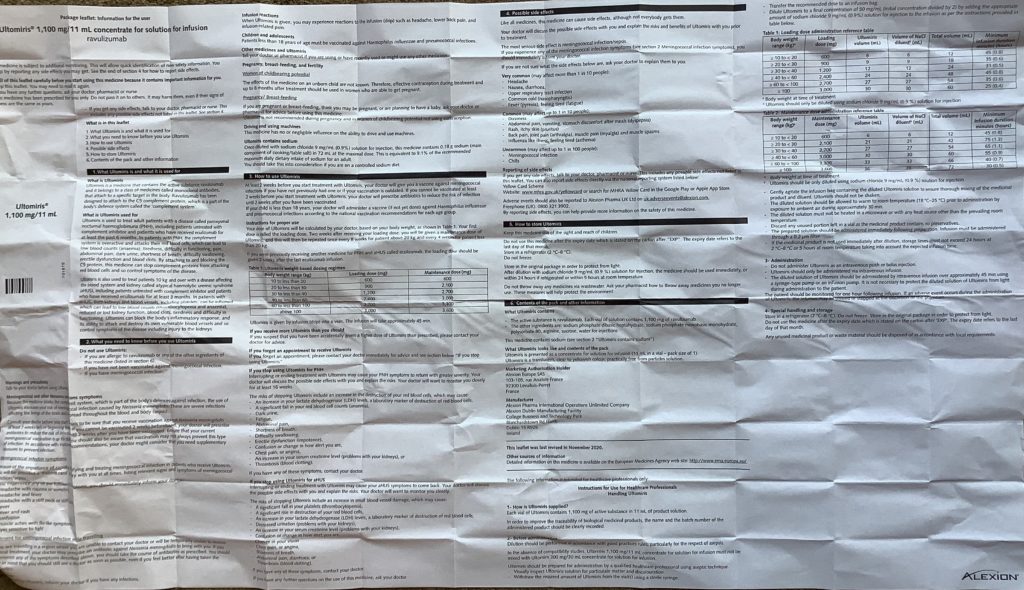Have you ever seen or read the medication guidance for using Eculizumab, or even Ravulizumab? There is one in every vial carton containing these medications. When it is unfolded it looks something like the image below.

“Looked like” because each country may have a different layout or document. This crumpled document is the European version for Ravulizumab.
The medication guide which follows is for eculizumab in the USA and is extracted from the latest version of the full document which will appear in eculizumab vial cartons soon. It has been approved by the FDA. USA aHUS patients can see the full “02/2024 updated version of the document” on the “Ultomiris website” at this link HERE.
Though versions in patients’ own countries in the rest of the world may include some country specific info e.g. for adverse events reporting etc, the information in the new eculizumab medication guide below can provide a reminder about meningococcal infection risks and the likely side effect/adverse events of treatment.
Patients from outside USA can ask your infusion care provider for a copy of the patient information in the cartons of the vials used for your treatment.
USA patients also could ask for a copy of their carton leaflet when the paper version appears in their vial cartons in a month or so. They will only be thrown away otherwise!
MEDICATION GUIDE
SOLIRIS® (so-leer-is)
(eculizumab)
injection, for intravenous use
What is the most important information I should know about SOLIRIS?
SOLIRIS is a medicine that affects your immune system. SOLIRIS may lower the ability of your immune system to
fight infections.
- enroll in the SOLIRIS REMS program
- SOLIRIS increases your chance of getting serious meningococcal infections caused by Neisseria meningitidis
bacteria. Meningococcal infections may quickly become life-threatening or cause death if not recognized and
treated early.
-You must complete or update your meningococcal vaccine(s) at least 2 weeks before your first dose of SOLIRIS.
-If you have not completed your meningococcal vaccines and SOLIRIS must be started right away, you should
receive the required vaccine(s) as soon as possible.
-If you have not been vaccinated and SOLIRIS must be started right away, you should also receive antibiotics to
take for as long as your healthcare provider tells you.
-If you had a meningococcal vaccine in the past, you might need additional vaccines before starting SOLIRIS. Your
healthcare provider will decide if you need additional meningococcal vaccines.
-Meningococcal vaccines do not prevent all meningococcal infections. Call your healthcare provider or get
emergency medical care right away if you get any of these signs and symptoms of a serious
meningococcal infection:
fever
fever with high heart rate
headache and fever
confusion
body aches with flu-like symptoms
fever and a rash
headache with nausea or vomiting
headache with a stiff neck or stiff back
eyes sensitive to light
Your healthcare provider will give you a Patient Safety Card about the risk of serious meningococcal infection.
Carry it with you at all times during treatment and for 3 months after your last dose of SOLIRIS. Your risk of
meningococcal infection may continue for several weeks after your last dose of SOLIRIS. It is important to show this cardto any healthcare provider who treats you. This will help them diagnose and treat you quickly.
SOLIRIS is only available through a program called the SOLIRIS Risk Evaluation and Mitigation Strategy (REMS).
Before you can receive SOLIRIS, your healthcare provider must: - counsel you about the risk of serious meningococcal infections
- give you information about the signs and symptoms of serious meningococcal infection
- make sure that you are vaccinated against serious infections caused by meningococcal bacteria and that you receive
antibiotics if you need to start SOLIRIS right away and you are not up to date on your vaccines - give you a Patient Safety Card about your risk of meningococcal infection, as discussed above
SOLIRIS may also increase the risk of other types of serious infections caused by encapsulated bacteria, including
Streptococcus pneumoniae, Haemophilus influenzae, and Neisseria gonorrhoeae. - If your child is treated with SOLIRIS, your child should receive vaccines against Streptococcus pneumoniae and
Haemophilus influenzae type b (Hib). - Certain people may be at risk of serious infections with gonorrhea. Talk to your healthcare provider about whether you are at risk for gonorrhea infection, about gonorrhea prevention, and regular testing.
- Certain fungal infections (aspergillus) may also happen if you take SOLIRIS and have a weak immune system or a low white blood cell count.
For more information about side effects, see “What are the possible side effects of SOLIRIS?”
What is SOLIRIS?
SOLIRIS is a prescription medicine used to treat: - people with paroxysmal nocturnal hemoglobinuria (PNH).
- people with atypical hemolytic uremic syndrome (aHUS).
SOLIRIS is not for use in treating people with Shiga toxin E. coli related hemolytic uremic syndrome (STEC-HUS). - adults with generalized myasthenia gravis (gMG) who are anti-acetylcholine receptor (AchR) antibody positive.
- adults with neuromyelitis optica spectrum disorder (NMOSD) who are anti-aquaporin-4 (AQP4) antibody positive.
It is not known if SOLIRIS is safe and effective in children with PNH, gMG, or NMOSD.
Who should not receive SOLIRIS?
Do not receive SOLIRIS if you have a serious meningococcal infection when you are starting SOLIRIS treatment.
Before you receive SOLIRIS, tell your healthcare provider about all of your medical conditions, including if you: - have an infection or fever.
- are pregnant or plan to become pregnant. It is not known if SOLIRIS will harm your unborn baby.
- are breastfeeding or plan to breastfeed. It is not known if SOLIRIS passes into your breast milk.
Tell your healthcare provider about all the medicines you take, including prescription and over-the-counter medicines,vitamins, and herbal supplements. SOLIRIS and other medicines can affect each other causing side effects.Know the medications you take and the vaccines you receive. Keep a list of them to show your healthcare provider andpharmacist when you get a new medicine.
How should I receive SOLIRIS? - Your healthcare provider will give you SOLIRIS into your vein through an intravenous (IV) line usually over 35 minutes
in adults and 1 to 4 hours in children. - Adults will usually receive a SOLIRIS infusion:
o weekly for 5 weeks, then
o every 2 weeks. - Children less than 18 years of age, your healthcare provider will decide how often you will receive SOLIRIS depending
on your age and body weight. - After each infusion, you should be monitored for at least 1 hour for infusion-related reactions. See “What are the
possible side effects of SOLIRIS?” If you have an infusion-related reaction during your SOLIRIS infusion, your
healthcare provider may decide to give SOLIRIS more slowly or stop your infusion. - If you miss a SOLIRIS infusion, call your healthcare provider right away.
- If you have PNH, your healthcare provider will need to monitor you closely for at least 8 weeks after stopping
SOLIRIS. Stopping treatment with SOLIRIS may cause breakdown of your red blood cells due to PNH.
Symptoms or problems that can happen due to red blood cell breakdown include:
o drop in the number of your red blood
cell count
o kidney problems
o drop in your platelet
counts
o blood clots
o confusion
o difficulty breathing
o chest pain - If you have aHUS, your healthcare provider will need to monitor you closely for at least 12 weeks after stopping
SOLIRIS for signs of worsening aHUS symptoms or problems related to abnormal clotting (thrombotic
microangiopathy).
Symptoms or problems that can happen with abnormal clotting may include:
o stroke
o difficulty breathing
o confusion
o kidney problems
o seizure
o swelling in arms or legs
o chest pain (angina)
o a drop in your platelet count
What are the possible side effects of SOLIRIS?
SOLIRIS can cause serious side effects including: - See “What is the most important information I should know about SOLIRIS?”
- Serious infusion-related reactions. Serious infusion-related reactions can happen during your SOLIRIS infusion. Tell
your healthcare provider or nurse right away if you get any of these symptoms during your SOLIRIS infusion:
o chest pain
o trouble breathing or shortness of breath
o swelling of your face, tongue, or throat
o feel faint or pass out
If you have an infusion-related reaction to SOLIRIS, your healthcare provider may need to infuse SOLIRIS more slowly, or
stop SOLIRIS. See “How will I receive SOLIRIS?”
The most common side effects in people with PNH treated with SOLIRIS include: - headache
- pain or swelling of your nose or throat (nasopharyngitis)
- back pain
- nausea
The most common side effects in people with aHUS treated with SOLIRIS include: - headache
- diarrhea
- high blood pressure
(hypertension) - common cold (upper
respiratory infection - stomach-area
(abdominal pain) - vomiting
- pain or swelling of
your nose or throat
(nasopharyngitis) - low red blood cell
count (anemia) - cough
- swelling of legs or
feet (peripheral
edema - nausea
- urinary tract infections
- fever
The most common side effects in people with gMG treated with SOLIRIS include: - muscle and joint (musculoskeletal) pain
The most common side effects in people with NMOSD treated with SOLIRIS include: - common cold (upper respiratory infection)
- pain or swelling of your nose or throat (nasopharyngitis)
- diarrhea
- back pain
- dizziness
- joint pain (arthralgia)
- throat irritation (pharyngitis)
- bruising (contusion)
- flu like symptoms (influenza) including fever, headache,
tiredness, cough, sore throat, and body aches
Tell your healthcare provider about any side effect that bothers you or that does not go away. These are not all the
possible side effects of SOLIRIS.
Call your doctor for medical advice about side effects. You may report side effects to FDA at 1-800-FDA-1088.
General information about the safe and effective use of SOLIRIS.
Medicines are sometimes prescribed for purposes other than those listed in a Medication Guide. You can ask your
pharmacist or healthcare provider for information about SOLIRIS that is written for health professionals.
What are the ingredients in SOLIRIS?
Active ingredient: eculizumab
Inactive ingredients: polysorbate 80 (vegetable origin), sodium chloride, sodium phosphate dibasic, sodium phosphate
monobasic, and Water for Injection
Manufactured by: Alexion Pharmaceuticals, Inc., 121 Seaport Boulevard, Boston, MA 02210 USA. US License Number 1743
This Medication Guide has been approved by the U.S. Food and Drug Administration Revised 02/2024
Article No 642

